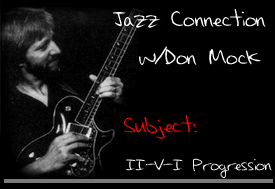
Don Mock:
The II-V-I Progression, every musician who studies jazz finds themselves in the land of
II-V-I's at some point in their learning. This short chord progression
offers an immense amount of possible harmonic and melodic substitutions.
Don Mock:
Most players, including myself, would have to admit that nearly
everything we know how to play from licks, substitution concepts, chord
voicings etc., can be applied to a II-V-I progression. It's the ultimate
study of the workings of music; all packed into three little chords.
Don Mock:
II-V-I progressions are the mainstay of traditional jazz standards.
Many tunes owe their entire structure to linked II-V-I's in various
keys. A trip through any "fake" book reveals hundreds of tunes crammed
with II-V-I progressions.
Don Mock:
The II-V-I is a perfect teacher of "tension/resolution" regardless of
which style/era you want to play. I would bet that most modern jazz
players, who are known for employing techniques such as
"superimposition" or "playing outside," probably paid their dues
learning II-V-I phrases and substitutes.
Don Mock:
Let's start with a few chord voicings. Here is a classic position for a
II-V-I in C. Dm7-G7-Cmaj7.
Don Mock:
these are very stock traditional voicings,
but are used by everyone,
btw: we are hanging around the 3rd fret area for now,
for me this a master position,
one of two that is,
here is a track of D min7
Don Mock:
G7, and two bars of Cmaj7
Don Mock:
these voicings are more of what guys normally play,
this is how I play Dmin7 all the time,
we're playing just extended chords only, no altered chords,
until next week
Rick:
when would you play the 1st set of chords vs. the 2nd set?
Don Mock:
the whole deal with playing chords is improvising just like single notes,
it's up to you at the time....
both sets work equally the same,
you should think of chord playing like slow motion soloing,
the top notes of chords stand out and create a melody
kito:
i m hearing chords/how to i get your solo?
Don Mock:
we're getting there kito,
BTW I'm hoping that you guys had a chance to learn the II-V-I licks for last week
Bill:
what do you call the top notes
Don Mock:
top notes or highest notes,
here's another group of chords
Don Mock:
one thing to remember is that most of the best guitar voicings have only 3 or 4 notes.
Your goal over the next week or so is to learn some II-V-I chords in
another position. In this same key (C), another good location is around
the 8th fret. Here's the basic ones to get you started.
Bill:
what is chord voicing ?
Don Mock:
"voicing" is a term for a chord or group of notes in music,
it's like an inversion,
it comes from vocal music
Don Mock:
let's move up to the 8th fret area for a sec,
it's best to learn chords in family groups,
like the coming file
Rick:
I suppose there are hundreds of these chord combinations
Don Mock:
there are hundreds of chord combinations but you only have to learn a small number of them,
these three chords are all voiced at root-5th, 7th, 3rd
Bill:
you said chords in a family do you mean like C F G
Don Mock:
not really bill,
these three chords are the same chord to me,
except for the modifications to the 3rds and 7ths,
here's another family group
Don Mock:
I use these voicing everyday
Chris:
can these chords be used in blues progressions also?
Don Mock:
stand by,
for you advanced guys, here's one of the coolest family groups for these three chords
LarryWjazz:
These are especially useful in blues progressions. Very cool Don.
Don Mock:
here is a common Gmaj7,
can you change it by locating the 7th and changing it to a G7 chord?
now how about Gm7,
this is a great way to learn new chords- modify the ones you already know
LarryWjazz:
One finger for the whole operation moved
Rick:
it's easy when the root is on the E string,
for me anyway
Don Mock:
the 7th is on the D string
the 3rd is on the G string
Mark:
Don - For chord group 3, on the cm9, how do you do a stretch from 4th to 8th?
Don Mock:
Mark- stretches take practice
play the chords up higher on the neck at first,
it won't take long,
I'll send pictures
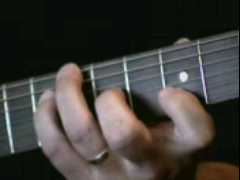
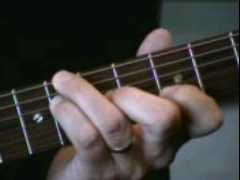
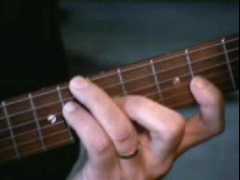
Don Mock:
the picture order is the same as the Cmaj9 file,
Joe Diorio has very small hands
yet can play some of the biggest stretches you ever saw
Matt1:
So does shawn lane- nothing stopping him
LarryWjazz:
but try playing some of his chords
Smitty:
Reinhardt didn't even have all his fingers...
Don Mock:
Now it's blues time guys. Let's take a look at a jazz style blues
progression. This one is in the key of G and has several II-V-I's within
the 12 bars.
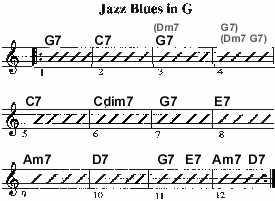
Don Mock:
let's find the II-V-I in this standard blues progression
Matt1:
DGC
Don Mock:
the first obvious place is bars 9, 10, & 11
LarryWjazz:
Am7 d7 g7
Don Mock:
another II-V-I location we'll look at is bar 4 (Dm7-G7) and bar 5
(C7). In this case the I chord is a dominant 7th (C7) The only
difference is you have to treat the C7 as a dominant 7th in the key F. Here's the jam track
Don Mock:
With the jazz blues Jam Track, practice the chords. When you get to
bars 4 and 5, play our new chords. Don't forget to play C7 instead of
Cmaj7.
A variation you can play is to start the Dm7 earlier. Play Dm7 for bar
3, G7 for bar 4, and C7 for bar 5.
Now add another II-V-I in bars 9, 10 and 11 (Am7-D7- G7 etc.) Just
slide our voicing up to the key of G.
Let's change gears and look at some scales to use over a II-V-I. When
in doubt, you can always play the key center major scale over all three
chords. Play a C major scale over a II-V-I in C. That's it.
Here's the pattern I'd use for C major around the third fret.
Don Mock:
I'm throwing in the primary arpeggios in the same area for Dm7, G7 and Cmaj7. Here's the audio:
LarryWjazz:
Mixo
Don Mock:
If you would like to create additional tension over the V chord, The
melodic minor scale is the top choice. There are actually four different
melodic minors that can be played over a V chord.
But the the most popular is the melodic minor that lives 1/2 step above
the root of the V chord. Play Ab melodic minor over the G7 in a II-V-I
in C. But remember, only over the G7. You must resolve back to the C
major scale when you arrive at the Cmaj7 chord. In our blues, resolve to
the F major scale for the C7 version of the I chord.
Here is a good pattern for Ab melodic minor in the 3-4th fret area.
LarryWjazz:
Don just curious, did you study with Howard roberts prior to git
Don Mock:
Larry: yes, Howard was a great friend since '73.
Now's a good time for me to plug my new book on the melodic minor scale.
It's called "Guitar Scale Secrets; Exploring Melodic Minor" from Warner
Bros. It's got just about everything I know about the melodic minor
scale. If you can't find it in a nearby store, you can order it from
Guitar Axis com.
Chris:
i have a quest...whats the difference between a arpeggio and a scale...and how do you practice arpeggios...I always associated them with fingerstyle guitar
Don Mock:
an arpeggio is the notes of a chord played one note at a time, most arpeggios
are only three or four notes long,
they just repeat over and over in octaves
LarryWjazz:
What about the Harmonic Minor book Don. You are too modest
Don Mock:
yes Larry I'm big on Harmonic Minor,
Joe Diorio and I use to try to come up with the most outrageous harmonic minor licks
Bill:
I thought that arpeggios were the 1st 2st and 3rd of a chord,
i mean the 5th
Don Mock:
Bill your close, but arpeggios are every other note in a scale,
lick 1, 3, 5, 7, etc.
I hope to see you next week and check out the chord phrases in the this week's EMP "lick of the day"
|
<< load notation from left
|